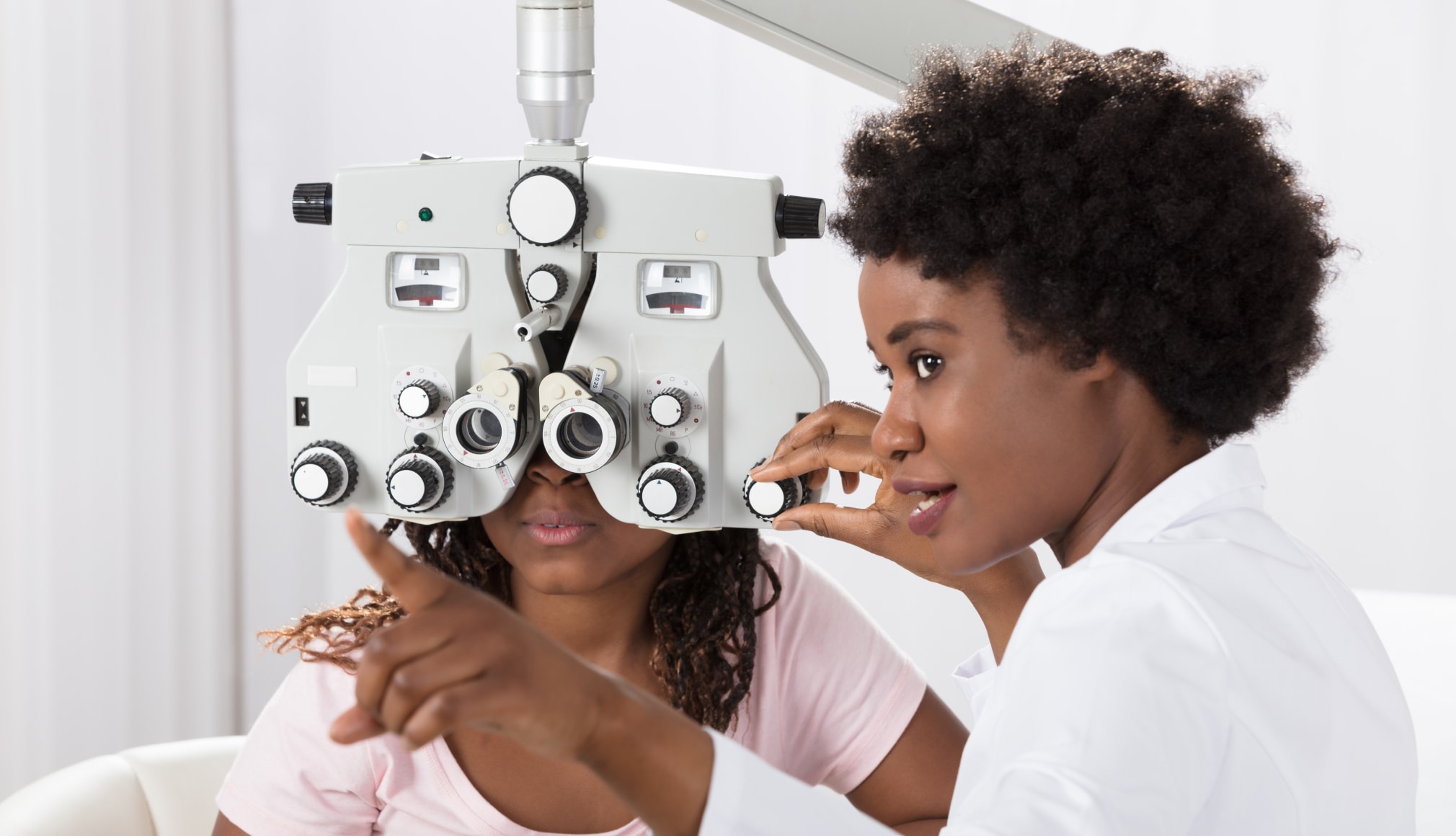
LASIK
LASIK – an acronym for laser in situ keratomileusis – is a laser eye surgery procedure performed to correct vision issues like farsightedness, nearsightedness, and astigmatism.


What is LASIK Eye Surgery?
It’s the most popular, and most performed, laser vision correction procedure available to patients today. Since LASIK eye surgery was first approved by the FDA nearly 30 years ago, more than 40 million LASIK procedures have been performed in the U.S. Because of decades of experience and the more than 7,000 clinical research studies, LASIK remains an excellent option for vision correction for those who are good candidates.

What Does LASIK Surgery Correct?
LASIK corrects a variety of common vision problems, including myopia (nearsightedness), hyperopia (farsightedness), astigmatism (irregular cornea), and presbyopia (“aging eyes”).
Vision prescriptions are measured in “diopters” – a measurement of the focusing power of the eye. Advanced laser vision correction procedures can treat a range of prescriptions including:
- +6.00 Diopters of hyperopia
- Astigmatism up to 6 diopters
- Nearsightedness up to -12.00 diopters
How Does LASIK Work?
LASIK is done in two steps:
First, the surgeon uses a femtosecond laser or a microkeratome to make a micron-thin, circular flap in the cornea – the surface of the eye. This takes just a few seconds. The surgeon gently moves the flap to expose the layer of tissue where the vision correction treatment will happen.
In the second step, a computer-guided excimer laser permanently reshapes the corneal tissue to improve its focusing ability. The flap is then laid back in place to act as a natural bandage, protecting the reshaped portion of the cornea while it heals. These two steps are virtually painless.
Today’s LASIK also features advanced technologies people can choose to customize the procedure with increased precision. These modern custom LASIK options include topography guided, wavefront guided, and wavefront optimized procedures.
Topography-Guided LASIK: The goal of a vision correction correction procedure is to shape the cornea to improve its ability to focus. With topographic-guided LASIK, sophisticated computer-assisted technology generates a digital 3D map of the curvature of the surface of cornea – the first field of focus for the eye. Topographic measurements for each patient’s cornea customizes the vision correction procedure to the precise shape needed to improve vision.
Wavefront-Guided or Wavefront-Optimized LASIK: Wavefront technology uses light waves to diagnose the presence of and measure higher-order aberrations on the surface of the cornea. These microscopic irregularities can impact the quality of vision and are unique to each individual eye. The data collected from wavefront technology is used to customize the vision correction performed by the excimer laser by reducing or eliminating the patient’s higher order aberrations and improving the patients quality of vision.
Does LASIK Hurt?
LASIK eye surgery uses numbing drops to anesthetize the eye before and during the procedure. Patients feel some pressure from the eyelid holder used to prevent blinking. Otherwise, numbing and lubricating drops help to keep the patient comfortable during the procedure.
Are You Awake During LASIK?
Yes. The surgeon needs you to be able to focus your eye during the procedure. However, the numbing drops and the valium or other sedative will keep you comfortable and calm. You don’t need to worry; if your eye moves, the laser’s tracking capabilities follow your eye. If you sneeze or abruptly move your body too much, the laser automatically turns off.

Lasik Success Rate
The LASIK success rate is well-understood based upon data from thousands of clinical studies looking at outcomes and patient satisfaction. The latest research reports:
- 99 percent of patients achieve better than 20/40 vision
- More than 90 percent achieve 20/20 or better
LASIK eye surgery also has one of the highest patient satisfaction rates of any elective procedure: more than 96 percent. Many patients have better vision than they did with their best glasses prior to surgery.
Candidate for Lasik Surgery?
Having a thorough eye exam and consultation with a highly qualified surgeon is how you find out if you are a good candidate for LASIK or other laser vision correction procedures. It is important because, on average, 15-20 percent of patients aren’t considered candidates for LASIK (but might be for another vision correction procedure).
- LASIK is FDA-approved for people aged 18 and older
- A stable prescription, meaning your prescription hasn’t changed in two years
- You and your eyes should be generally healthy and free of diseases, injuries, and infections
Is LASIK Safe?
LASIK is among the most studied, and thus safest, elective procedures. More than 7,000 clinical studies have been conducted and published about LASIK. Bottom line: there is a tremendous amount of data supporting the safety and effectiveness of laser vision correction.
And just to be clear, in more than 40 million procedures performed worldwide, in anyone who is a good candidate, there has never been a case of blindness because of LASIK.
LASIK Side Effects Effects
It is normal to experience some symptoms after surgery, which is part of the healing process. Even though it takes about 15 minutes, LASIK is a surgical procedure. There is recovery and healing that takes place after. During the recovery period, your eyes may feel a little dry, light-sensitive, or irritated while they heal. Be sure to talk with your doctor about your symptoms during your post-procedure checkups.
A few patients experience side effects after LASIK. Generally, these include night vision visual symptoms such as glare, halos, ghosting, and starbursts, as well as dry eye. These symptoms are typically mild and resolve by themselves within a few weeks or months, perhaps up to a year. Some people need additional eye drops to help reduce inflammation and/or dry eyes that can contribute to visual symptoms. In rare cases, an eye doctor may recommend additional LASIK treatment to address residual vision problems.
What to do Before LASIK Surgery?
After the eye exam and LASIK consult, and you are ready to move forward and schedule a date, there may be a few things you need to do in the days leading up to your surgery. Your surgeon will go over the specifics for you, and be sure you share your full medical history, but:
- If you wear contact lenses you may need to stop wearing them for a few days, maybe up to a couple of weeks, before the surgery.
- The day before surgery you should stop using lotions, creams, and makeup. You want the area around your eyes to be clean.
- You will need a ride home from the procedure and you may want someone around to take care of you for a few hours when you get home. Ask a friend or family member.
LASIK Recovery Time
Right after the procedure, your vision will be a little foggy but you should see much clearer within a few hours. Generally, once the local anesthesia wears off, some patients experience mild discomfort which, on average, lasts about 5 hours. Your doctor will give you instructions about what and how much pain reliever to take.
You should rest your eyes for a few hours after you get home, most people take a nap. You will be given some eye drops to use to help keep your eyes lubricated and to help with healing.
To help you avoid rubbing your eyes, you may be given some goggles or eye patches to sleep in. You will want to wear a good pair of sunglasses outside as your eyes may be sensitive to bright light.
You will want to avoid any strenuous activity or exercise until your surgeon clears you – usually at your first follow-up appointment a day or two after the procedure.
LASIK Eye Surgery Cost
LASIK is a surprisingly affordable option for vision correction when you compare the cost of the procedure to a lifetime of purchasing glasses and contact lenses. Some vision plans offer some benefits, but you should expect to pay for most of the procedure yourself. Providers have financing plans available if you aren’t able to pay the cost upfront.
Read about LASIK cost in more detail.

Is LASIK Right For Me?
Millions of people have benefitted from laser vision correction, calling it the best decision they’ve made and the best money they’ve ever spent. Your surgeon will tell you if you are a good candidate and recommend specifics about the procedure. However, only you can decide if LASIK eye surgery is right for you and your lifestyle.
There are a handful of LASIK alternatives beyond eyeglasses and contacts, including PRK, SMILE and ICLs. These surgical procedures are newer than standard LASIK, but have success and satisfaction rates comparable to the procedure. You can read more about PRK, SMILE and ICLs on the RSC site.

Jump to
Section
- What is LASIK Eye Surgery?
- What Does LASIK Surgery Correct?
- How Does LASIK Work?
- Does LASIK Hurt?
- Are you Awake During LASIK?
- Lasik Success Rate
- Candidate for Lasik Surgery?
- Is LASIK Safe?
- LASIK Side Effects Effects
- What to do Before LASIK Surgery?
- LASIK Recovery Time
- LASIK Eye Surgery Cost
- Is LASIK Right for Me?
Ready to take the next step?
Schedule a consultation today.






